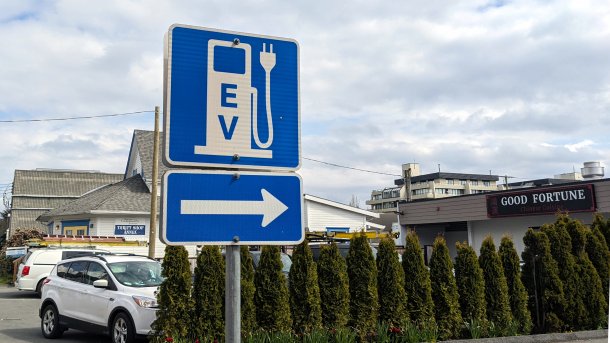USA: Electric cars lose market share, Tesla loses majority
GM sells many more electric cars, Tesla sells fewer. The absolute majority of the US market is gone. The e-market is growing slower than the non-electric market.

The US car industry fears a glaring lack of charging stations.
(Image: Daniel AJ Sokolov)
The US market for electric cars is changing. As expected, Tesla lost its absolute majority in the second quarter of 2024. This is because Tesla's sales are falling, while its competitors are selling significantly more electric vehicles. General Motors (GM) has set a new record and, according to its own figures, delivered 21,930 electric vehicles - an increase of 40 percent year-on-year.
Tesla remains the undisputed market leader. The company delivered 443,956 electric cars worldwide in the second quarter of 2024, the vast majority of which were Model 3s and Ys. That is a decline of 4.7 percent for Tesla. However, the company does not break down this statistic by region or country, as some other manufacturers do. So market researchers have to combine data from manufacturers, registration authorities and dealers. Based on this, Cox Automotive estimates that Tesla's share of the US electric car market fell to 49.7 percent in the second quarter. This was reported by the New York Times, citing Cox. In addition to GM, Ford and Hyundai/Kia in particular have made gains.
Videos by heise
A year ago, Tesla's estimated market share was around ten percentage points higher. Overall, sales of new electric road vehicles have risen by 11.3 percent year-on-year to more than 330,000 units, the market researchers report. However, this also means that market growth has fallen sharply. In the previous year, growth rates were still above 40 percent. And it means that sales of electric cars are now growing more slowly than cars with other drive systems - while the number of electric car registrations in Germany is actually falling sharply.
Ransomware puts the brakes on car sales
In other words, the share of electric cars in the overall new car market in the USA is shrinking. Although their share of eight percent in the second quarter of 2024 is slightly higher than in the second quarter of 2024 (7.2 percent), it is below the figures for 2024 as a whole (9.5 percent according to the industry association AAI) and the most recent three quarters. Whether this is a long-term trend remains to be seen. High tariffs could further slow down demand for electric vehicles.
The lion's share of new cars sold is still accounted for by classic combustion engines, whose market share is constantly declining. However, sales figures for hybrid cars are rising sharply. Plug-in hybrids, i.e. combustion engines with batteries that can be charged at the socket, are growing less strongly, but still.
Empfohlener redaktioneller Inhalt
Mit Ihrer Zustimmung wird hier eine externe Umfrage (Opinary GmbH) geladen.
Ich bin damit einverstanden, dass mir externe Inhalte angezeigt werden. Damit können personenbezogene Daten an Drittplattformen (Opinary GmbH) übermittelt werden. Mehr dazu in unserer Datenschutzerklärung.
The actual demand from new car buyers could be even more unpleasant for Tesla than the statistics make it look. Since June 19, the US car trade has been affected by a serious case of ransomware extortion. Over 15,000 US car dealers use software and cloud services from CDK Global, which have gone offline as a result of the attack. The damage to the industry is enormous, with 7.6 percent fewer new cars sold in the USA in June than in May.
Also affected are workshop services and used car sales by dealers, who have to revert to paper and pencil but have no real insight into their inventory. This has slowed down sales for many brands, including Tesla in some US states, because it was unable to register cars sold there electronically with the registration authority. CDK Global's programs have only been running again since Independence Day, 4 July.
More choice of e-vehicles, increasing lack of charging stations
66 different types of battery-powered road vehicles were on the market in the USA in the first quarter, according to AAI (Alliance for Automative Innovation). A year ago, there were 55 types. (Incidentally, there are still two fuel cell types.) A year ago there were still subsidies from US federal funds for all of them; now the subsidy depends on where the materials for the batteries are mined and where the batteries are then produced. Only ten current electric cars qualified for the full subsidy of 7,500 US dollars in the first quarter, including certain Tesla models in the 3, X and Y series and the VW ID.4. Three other models can still claim half the subsidy (Nissan Leaf and Rivian R1S and R1T).
On the one hand, the high prices are scaring off customers, while on the other, the increasing choice is attracting other customers. While the electric car industry once concentrated on passenger cars, it is now making a name for itself with SUVs. They already overtook electric cars three years ago. Electric pick-ups are now entering the US market, with five models so far. They appeal to additional customer segments.
What is missing are public charging stations, and this is becoming increasingly urgent, says the AAI. The pace of expansion is lagging far behind the growth in the fleet. By 2030, an additional public charging point would have to be connected to the grid almost every three minutes in the USA in order to close the gap if the 33 million electric and plug-in hybrid cars expected to be on US roads in 2030 are to be used.
(ds)